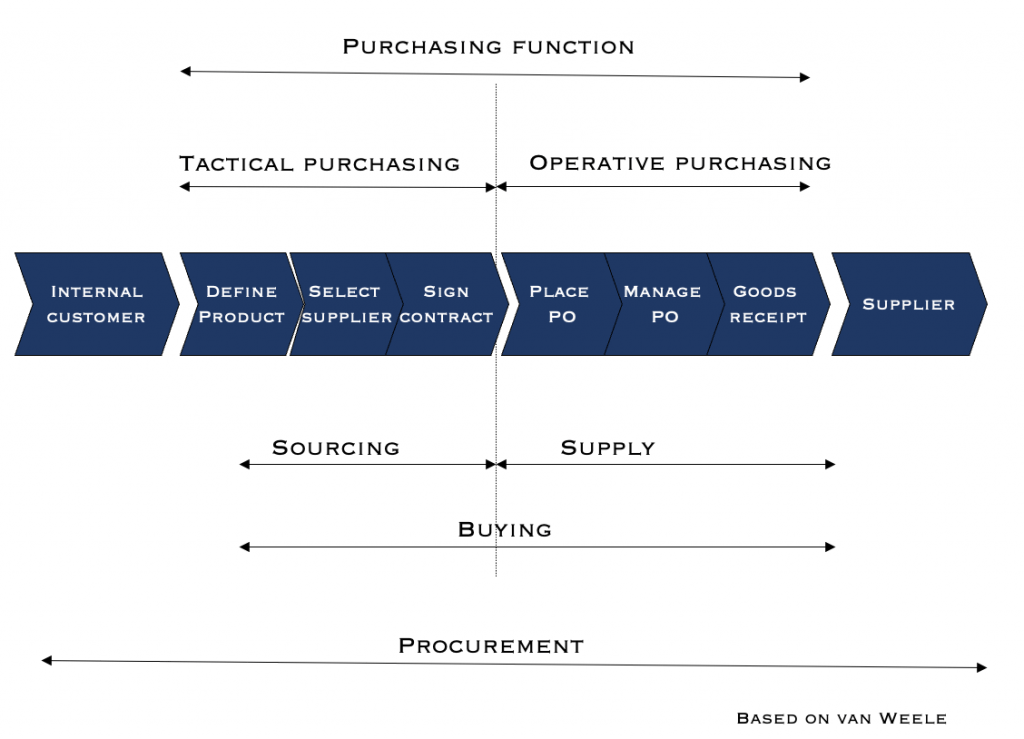Supply chains and Supply chain management can be complex, with various interrelated processes and terminology. In this blog post, we’ll introduce some of the most commonly used, introduction level terms, including purchasing, procurement, buying, supply chain, materials management, distribution, logistics, and contract management. Understanding these key supply chain terms forms a foundation for buyers in the beginning of their training.
Table of Contents
Key supply chain terms for buyers – Introduction level.
Purchasing
Purchasing refers to the process of acquiring goods or services from external suppliers to meet an organization’s needs. It involves identifying requirements, selecting suppliers, negotiating prices and terms, and processing payments. Purchasing is a critical component of the overall procurement process, as it directly impacts the cost, quality, and availability of the products or services required by the organization.
Procurement
Procurement is a broader term encompassing the entire process of acquiring goods and services, from identifying needs and sourcing suppliers to contract management and payment. It goes beyond purchasing to include strategic planning, risk management, and supplier relationship management. The main goal of procurement is to ensure the organization obtains the required goods or services at the best possible value, considering factors such as cost, quality, delivery times, and supplier performance. At Learn How to Source we rely on Arjan van Weele’s definition of Purchasing and Procurement.

Buying
Buying is a term often used interchangeably with purchasing, but it generally refers to the more transactional aspect of acquiring goods or services. Buying focuses on the actual act of placing orders and making payments, rather than the strategic and planning elements involved in procurement.
Supply Chain
The supply chain encompasses all the activities, processes, and organizations involved in the production, transportation, and delivery of goods and services from the point of origin to the end customer. It includes procurement, materials management, distribution, logistics, and other related functions. Effective supply chain management ensures the smooth flow of products and information, minimizing costs and maximizing efficiency.
Materials Management
Materials management involves the planning, control, and coordination of all aspects related to the movement and storage of raw materials, work-in-process inventory, and finished goods. It aims to ensure the right materials are available at the right time, place, and quantity to meet production and customer demand. Materials management plays a crucial role in optimizing inventory levels, reducing waste, and ensuring timely deliveries.
Distribution
Distribution refers to the process of storing, transporting, and delivering finished goods from the manufacturer or supplier to the end customer. It involves activities such as warehousing, inventory management, order processing, and transportation. Effective distribution management ensures products reach customers in the most efficient and cost-effective manner.
Logistics
Logistics is the management of the movement and storage of goods, materials, and information throughout the supply chain. It encompasses various activities, including transportation, warehousing, inventory management, and order fulfillment. Logistics plays a vital role in ensuring the timely and efficient delivery of products to customers while minimizing costs and operational inefficiencies.
Contract Management
Contract management involves the administration and oversight of contracts between an organization and its suppliers. It includes activities such as contract KPI, execution, monitoring, and termination. Effective contract management ensures both parties meet their contractual obligations, minimizing risks and fostering strong supplier relationships.
Summary Key Supply Chain Terms
Understanding these key supply chain terms is essential for anyone involved in the procurement and management of goods and services. By gaining a solid grasp of these concepts, professionals and businesses can better navigate the complexities of the supply chain, align language and thereby increase understanding.
In the blogpost Top 20 Supply Chain Terms for Buyers in Training you will find an extended basic level list of relevant Supply Chain Terms.
Get a good first understanding of Procurement by attending the the Introduction level courses at Learn How to Source. Find all courses at Next Step (scroll down to Introduction level).
Or go directly to our FREE Introduction level bundle where you will learn get an introduction to operative procurement, tactical procurement and procurement management. About the procurement basic roles and concepts and How Learn how LHTS organize it’s learning and finally how to integrate learning in your day to day work (we call it Micro learning).
About Learn How to Source
Learn How to Source (LHTS) is an online platform based in Sweden, offering a range of procurement courses accessible globally. It serves as a community where procurement experts share their knowledge through online courses, designed for various experience levels from introductory to expert. Courses are concise, about 30 minutes each, and cover different aspects of procurement, tailored for different buyer roles. The courses focus on practical knowledge, presented by seasoned professionals, and include quizzes and certificates. They can be accessed from any device, emphasizing micro learning for flexibility and efficiency.
Note: Illustration to the blogpost “Understanding Key Supply Chain Terms” was created by Chat GPT on June 13, 2024.
Information about our Online Procurement courses in Swedish.
